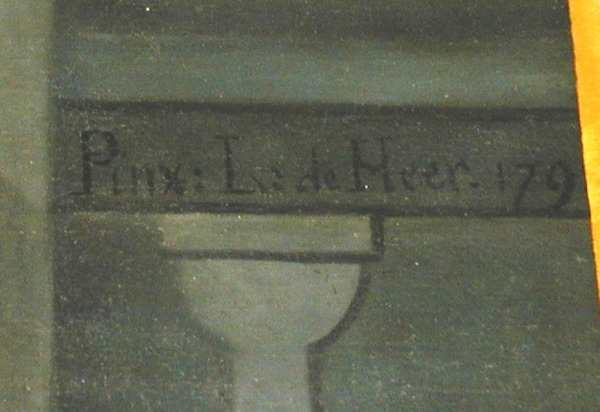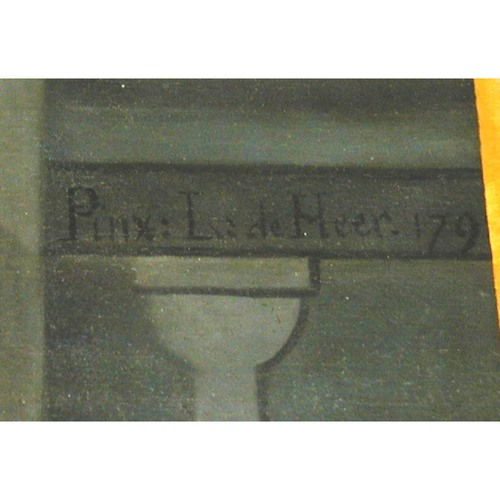
Source: Link
HEER, LOUIS-CHRÉTIEN DE, painter and gilder; b. 3 Nov. 1760 in Bouxwiller, France, son of Jean-Tobie Heer, commissary at the court of Bouxwiller, and Frédérique-Louise Ouvrier; d. some time before 1808.
Louis-Chrétien de Heer was baptized in the Lutheran faith and had three godfathers and two godmothers, all of whom were in the service of the gentry of Bouxwiller and the surrounding region. De Heer arrived in North America in 1776 as colour-bearer in the Regiment Specht in the troops from Brunswick which had come as mercenaries to support the British forces engaged in the American Revolutionary War.
After the war de Heer settled in Montreal, and there, on 25 July 1784, in Christ Church (Anglican), he married Marie-Angélique Badel, daughter of Antoine Badel, a tailor. In the period between 1785 and 1790 the couple had four daughters, who were baptized in either Montreal or Quebec, the two towns in which he practised his trade as painter and gilder.
In 1787 de Heer, who was living on Rue des Pauvres (Côte du Palais) at Quebec, put an advertisement in the Quebec Gazette announcing: “He will draw Pictures either in Oil or in Pastel, Landskips, Tapistries of all sorts . . . and he also engages to teach in a very short time such persons as may be inclined to learn Painting.” But as this activity did not provide enough to live on, two years later he signed an important contract with the parish priest of Saint-Charles, near Quebec – despite the fact that he was a Protestant – by which he undertook to do the gilding on the baldachin of the church and to execute seven paintings for the chancel portraying Christ and six of the apostles, as well as one of the Holy Ghost for the sanctuary and another of St John the Baptist for the baptismal font.
In September 1789, however, de Heer was back in Montreal, on Rue Saint-Paul, still looking for more lucrative contracts. His advertisement, which appeared this time in the Gazette de Montreal, promised “good work at a moderate price.” De Heer, it stated, “flatters himself on being able to gild with oil, sizing and copal varnish, and in addition offers to give all possible instruction . . . in painting.” He was anxious to attract clients, and it is apparent from his peregrinations that he could not find sufficient patronage in either town. He returned to Quebec, where in July 1790 he advertised his usual services, painting and teaching, and also informed the public “that he has received by the last ships from Europe, an Assortment of superfine Paints, books of various Flowers, Land capes, &c.” To survive, however, he had to appeal to his clientele by substantially reducing his prices for “the Pictures of half length.” That year he worked at gilding the retable (as the decorated structure housing the altar in the sanctuary was then known) in the church of Notre-Dame-de-Bon-Secours at L’Islet.
De Heer’s Catholic clients and also his wife’s family probably had an influence on him, for in September 1792, in the sick ward of the Hôtel-Dieu at Quebec, he abjured his Protestant faith and became a Catholic. In 1800 he and some former comrades in arms signed a petition for a tract of land, which was refused them. There is no subsequent information about the artist until 25 Jan. 1808, when his daughter Marie-Louise married Pierre-Guillaume De Lisle. In their marriage contract de Heer was reported to be absent from the country; the marriage certificate said that he was dead.
A great many religious paintings and portraits of citizens, military personnel, and ecclesiastics are attributed to Louis-Chrétien de Heer. None of these works is signed, however, and there is no documentary confirmation of these attributions, with the exception of a painting of St Louis in the church of Saint-Michel, at Vaudreuil, which bears de Heer’s name in block letters. De Heer probably had great difficulty in living on the income from his painting. Compared with the works of such contemporaries as François Malepart* de Beaucourt, Louis Dulongpré*, and William Berczy, the portraits attributed to de Heer are stiff and naïve in technique. His subjects, whether soldiers or ecclesiastics, are shown full face, with little depth. His use of colour and his emphasis on surface pattern make him, however, one of the best primitive portrait artists in Lower Canada. Like other little-known painters, he was an itinerant. Through force of circumstance de Heer was versatile; through misfortune he was in competition with several more accomplished artists.
AD, Bas-Rhin (Strasbourg), État civil, Bouxwiller, 3 nov. 1760. ANQ-M, CE1-51, 13 mai 1785, 30 nov. 1790, 25 janv. 1808, 6 janv. 1825; CN1-158, 25 juill. 1784; CN1-269, 23 janv. 1808. AP, Notre-Dame-de-Bon-Secours (L’Islet), Livres de comptes, 2: 81; Notre-Dame de Québec, Abjurations, 8 sept. 1792. ASSM, 19, tiroir 66A. MAC-CD, Fonds Morisset, 2, H459/L888.4. PAC, RG 1, L3L: 94214. Montreal Gazette, 17, 24 Sept. 1789. Quebec Gazette, 16 Aug. 1787, 29 July 1790. J. R. Harper, Early painters and engravers in Canada ([Toronto], 1970), 153–54; Painting in Canada, a history (Toronto and Quebec, 1966), 73, 75, 78, 424. Gérard Morisset, La peinture traditionnelle au Canada français (Ottawa, 1960), 63–66.
Cite This Article
Suzanne Lacasse Gales and Peter Moogk, “HEER, LOUIS-CHRÉTIEN DE,” in Dictionary of Canadian Biography, vol. 5, University of Toronto/Université Laval, 2003–, accessed December 31, 2025, https://www.biographi.ca/en/bio/heer_louis_chretien_de_5E.html.
The citation above shows the format for footnotes and endnotes according to the Chicago manual of style (16th edition). Information to be used in other citation formats:
| Permalink: | https://www.biographi.ca/en/bio/heer_louis_chretien_de_5E.html |
| Author of Article: | Suzanne Lacasse Gales and Peter Moogk |
| Title of Article: | HEER, LOUIS-CHRÉTIEN DE |
| Publication Name: | Dictionary of Canadian Biography, vol. 5 |
| Publisher: | University of Toronto/Université Laval |
| Year of publication: | 1983 |
| Year of revision: | 1983 |
| Access Date: | December 31, 2025 |



